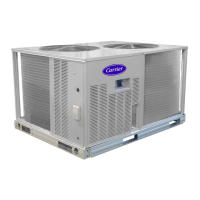20
OPERATING SEQUENCE
Base Unit Controls
Indoor (Supply) Fan —
The indoor fan contactor (IFC) is remotely located at the fan
coil or fan sectio n. If the thermo s tat fan op eratio n is selected
as Continuous, the IFC is energized and the indoor (supply)
fan motor runs continuously. If the thermostat fan operation
is selected as A u tomatic, the IFC will be ener g ized on a call
for Cooling; indoor (supply) fan motor runs. When
thermostat call for Cooling is satis f ied, the IFC is
de-ener gized and indoor (supply) fan motor stops.
Cooling, Unit Without Economizer —
On a thermostat call for Cooling, IFC will be energized
and indoor (supply) fan motor runs. Thermostat output Y1
is energized; terminal Y1 at 38AUZ unit receives 24-v.
24-v received at CADM1 terminal Y. If anti-recycle time
delay period has not expired, CADM1 relay will remain
open, de-energizing Solenoid Valve Relay (SVR) and
preventing compressor start. When safety pressure
switches are closed and CADM1 time delay expires,
CADM1 relay closes, SVR and compressor contactor C1
are energized; Compressor Relay Timer (CTR) is closed
and Digital Cycle Timer (CTD) is energized commanding
Digital Compressor Solenoid (DCS) on, liquid line
solenoid valve LLSV opens, al l outdoor fan m otors start
and Compressor starts part load operation.
On thermostat call for Stage 2 Cooling, thermostat output
Y2 is energized CTR receives 24--v at terminal 1 changing
conta cts to open. CTD is de--energized and commands
DCS off, Compressor operates at full load.
As space cooling load is satisfied, thermostat outputs Y2 and
Y1 are sequentially de--energized, removing 24--v at 38AU Z
terminals Y1 and Y2. Compressor resumes part load
operation on Y2 opening. On Y1 opening, Compressor 1
stops, all outdoor fan motors stop and SVR is de--ener gized.
Liquid Line solenoid valve is de--ener gized and valve closes.
CADM1 begins its three--minute anti--recycle time delay.
If either the Low Pressure Switch or High Pressure Switch
opens while thermostat output Y1 or Y2 re main energized,
the compressor contactor is de-energized, the compressor
stops and liquid line solenoid is de-energized (valve
closes). CADM initiates a TRIP event (cooling demand
sensed at CADM terminal Y but no current is measured at
T1, T2, T3 motor sensors); CADM relay opens and RED
LED is illuminated. TRIP condition m aintains lockout of
compressor operation until CADM is manually reset.
Reset CADM by cycling unit main power.
Complete system shutdown ma y be caused by loss of
main power, open compressor internal overload, open
low-pressure or high-pressure swit ch, or a fault detected
by the CADM logic. Compressor operation without
cooling may indicate the compressor’s ASTP feature is
act ive; disconnect unit power and al low compressor to
cool. See Service section for further details.
Cooling, Unit With Economizer —
Refer to fan coil unit installation instructions and
economizer accessory installation instructions for
operat ing sequences when system is equipped with
accessory economizer.
Heating —
Refer to fan coil unit installation instru ction s and access o r y
heating device installation instructio ns for operating
sequences in heating mode.
ROUTINE SYSTEM MAINTENANCE
These items should be part of a routine maintenance
prog r am, to be checked every month or two, un til a specific
sched u le for each can be identified f or this installation:
Quarterly Inspection (and 30 days after initial start) —
Indoor secti on
S Condenser coil cleanliness checked.
S Return air filter replacement
S Outdoor hood inlet filters cleaned
S Belt tension checked
S Belt condition checked
S Pulley alignment checked
S Fan shaft bearing locking collar tightness checked
S Condensate drain checked
Seasonal Maintenance —
These items should be checked at the beginning of each
season (or more often if local conditions and usage patterns
dictate):
Air Conditioning
S Condenser fan motor mounting bolts tightness
S Compressor mounting bolts
S Condenser fan blade positioning
S Control box cleanliness and wiring condition
S Wire terminal tightness
S Refrigerant charge level
S Evaporator coil cleaning
S Evaporator blower motor amperage
Heating
S Power wire connections
S Fuses ready
S Manual-reset limit switch is closed
Economizer or Outside Air Damper
S Inlet filters condition
S Check damper travel (economizer)
S Check gear and dampers for debris and dirt
38AU

